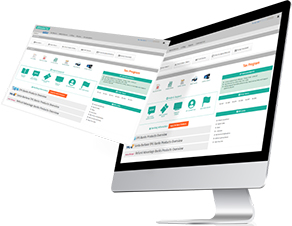How to work together as team in a virtual tax office
The idea of a virtual tax office has become a popular one in recent years. Indeed, months of lockdowns and limited face-to-face interactions have broadened the acceptance of remote office work. We may be seeing now what the future looks like.
You may have already gotten into the virtual office game. Or else you’re starting a tax business and thinking of implementing the concept. The trouble is, virtual team management is a new thing and most people have no experience of how to do it right.
There’s no question that a virtual office setup can succeed. Many businesses were temporarily forced to accept the arrangement and they made it work. But as it is a relatively new type of office setup, businesses don’t have any traditions to fall back on. Many of them are learning how to walk as far as virtual office work is concerned.
Keen on learning lessons from successful experiments in virtual team setups? Let’s take a look at what worked and how to apply it to your own business.
Start with a Vision and a Plan
Before you start running your virtual office, take some time to visualize how it would operate. Every business has a vision at its center. When a business makes a bold move, a vision should be behind that move.
Therefore a transition to a virtual office work arrangement requires a vision of efficient teamwork and management. This gives you a concrete objective to strive for as you implement the system. You can benchmark your progress and know how close you are to achieving your productivity goals.
Here are some pointers to consider when envisioning your work setup:
- Will you be managing the team directly? Or will the bulk of interactions be handled by a supervisor or even your personal assistant?
- How frequently will you be doing video calls with team members?
- Will you be relying on video calls for most team interactions? Or text messaging? Or emails?
- How much will your team need to collaborate? How will the collaborations take place?
- What kind of schedule will the team members follow? Will everyone have the same schedule? Will there be flexibility?
- How much training will your team members require? Are they a tech-savvy group? What about their data security competence? Can you ensure that they will follow best security practices? And that you will do so as well?
- What kind of tech setup will your team members have? How can you ensure that everyone has adequate equipment and software?
- How will you deal with tech support issues? Do you have a technician or tech advisor on your team? If not, do you have easy access to someone who can provide technical help?
Have a Fully Prepared Team
A vision is only as good as the team that works to achieve it. You want capable employees or contractors who will not only be comfortable with a virtual office approach, but thrive in it!
If you are starting a new business, then you can build a team with that factor in mind. Look for people who are skilled at using remote communications tools and other online apps. You can also accept those who are willing to be trained in the software tools they will need to use.
If your business is transitioning into remote work, then you have to evaluate the skills of your current team members. Give them a questionnaire to gather info about their levels of experience with key web platforms and mobile apps.
You can even test their skills, if you feel it is necessary. You want a team that you can be confident in, after all.
After these evaluations, you may decide that the team members will need additional skill training. You can choose to train them yourself, or you can find some online tutorials they can use to learn the proper skills. If software training is required, you might want to check with the software maker to see if they provide any training support.
In some cases, the training may be included in the software subscription package. So you won’t have to pay any additional fees in receiving the training services.
Preparing Your Clients
If you are transitioning to a virtual tax office arrangement, you will need to inform existing customers of the change. Take a marketer’s approach in giving them the information. Play up the idea that you are doing this for their convenience.
With a virtual office, your customers can communicate with you through online platforms. No need for them to visit the office for a face-to-face meeting. Even if they have documents to submit, they don’t need to go to your office to do that. They can submit electronic documents to you by online means.
Let them know of these benefits. Try to get them excited about the improvements they will be experiencing. Be prepared to answer their questions and respond to their concerns. Strive to come across as someone who is looking after their best interests.
If you have built up a trustworthy image with your clients, this task will be a lot easier. Customers who trust you will not need too much convincing. They can easily be persuaded to go along with the transition.
Are You Prepared?
You’ve prepared your team, and you’ve prepared your clients. But here’s the big question. Are you prepared?
It’s time to do some self-evaluation. Would you say that the transition is going to be a big leap for you? Or do you feel that it’s long overdue… that you’ve been ready for this for quite a while?
Do you feel that you need to update your skills? Do you think you’ll need some training? How much training? Can you train yourself, or will you need an instructor?
Keep in mind that this is not only about skill training or software knowledge. You also need to learn new ways of doing things. New systems, new procedures, new productivity measures, new forms of communication and documentation, and so on.
Your team members will be taking their cues from you. So you definitely want to set an example by being prepared and knowledgeable as a manager of a virtual tax preparation office. Leadership is required. You’ll need to steer the ship as you set on a new course.
Effective Systems for a Virtual Office
If you are used to the workflow procedures of a regular office, you will have to adapt to a different style of management. You’ll need to put new systems in place for work organization, team communications, and
Don’t worry, it’s not difficult. You simply need to make a few adjustments. Then you should have everything running smoothly.
Here are some examples of systems you’ll want to set up:
Communications – You and your team will be relying on online platforms to communicate with each other. This can mean video conferences, voice calls, real-time chat, voice mail, e-mail, and text messaging. You should standardize all of these channels, so that everyone is using the same platforms for each type of interaction. The same considerations apply to calendar apps.
Client Portal – You can’t always get clients to use the same interaction platforms that your office is using. But you can set up a client portal through which customers can communicate with your team, set appointments, and send digital files. That will provide the standardization that you want.
Security – All office personnel need to be trained in the best practices for online security. This can involve passwords, two-factor authorization, encryption, account access, and secure document management. You also need to control user authorizations and permissions connected to every software tool your office uses.
Document Management – Set up secure cloud storage for your office’s electronic documents. Having cloud storage ensures that you have backups of files that you can download in case you lose something. Files in cloud storage can be accessed from anywhere by an authorized user?—a welcome convenience. Be aware of who has access to what, and manage file access permissions accordingly.
Tracking and Monitoring – Set up systems to document team activity and track goal progress. This can involve daily or weekly reports, activity logs, checklists, calendars, etc. You may want to invest in office management software to keep things systematic. (Our recommendation: ProClient)
Using Tax Preparation Software
To make a virtual tax office work, you have to get a subscription to a tax preparation software service. This will provide you with a program you can use to automate tax form processing on behalf of your clients, and facilitate the electronic submission of completed returns to the IRS.
Nowadays, you’ll find many options for professional tax software on the market. With so many options, it can be difficult to narrow it down to a single product. If you don’t have the time to do a lot of research, no problem. You can check out this Professional Tax Software Comparison Chart to get an excellent overview of the various software products and their features.
UltimateTax Professional Tax Software is one of the most affordable and effective products in this category. It is easy to set up and intuitive to learn and use. You can streamline your tax return preparation workflow with UltimateTax and its powerful automation functions.






